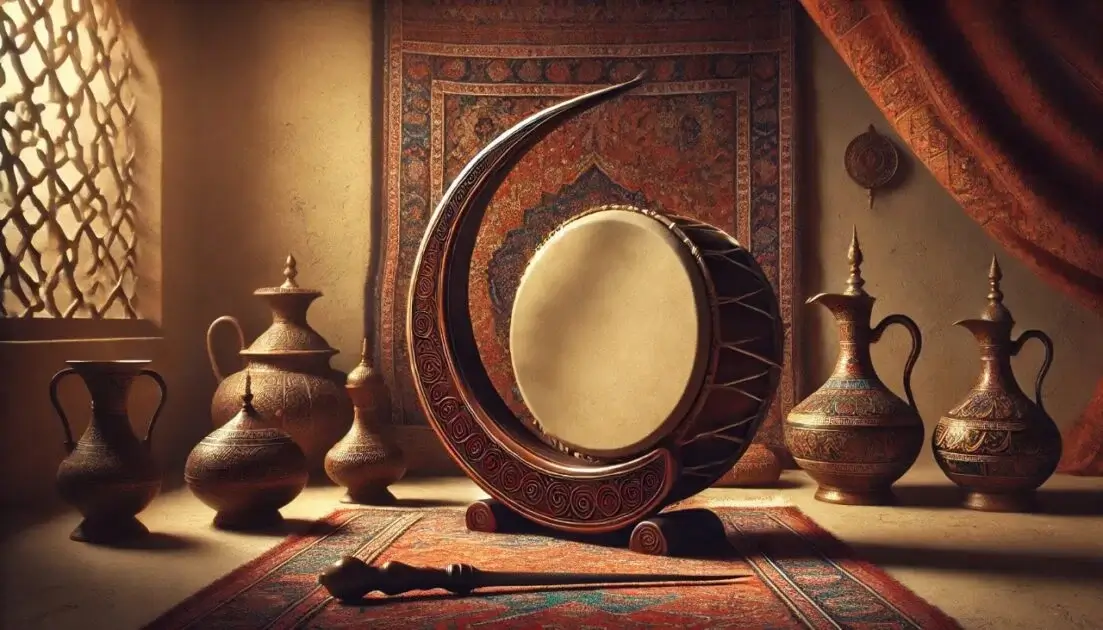A Sneak Peek into the Scimitar Drum
The Scimitar Drum is a thrilling cultural artifact. It is more than just a sound; it represents cultures and traditions. Its unique crescent shape and loud sound made it a well-known clansmen’s instrument in many areas. If you dream of being a musician or are curious about world instruments, the magic of the Scimitar Drum awaits you. Come and feel it. So, let us trace back to where it was made. And, to the people who made it. It inspired its unique sound, which is loved by many generations worldwide.
The Evolution Towards the Acceptance of the Scimitar Drum and Its Uses
This instrument is loaded with history, and the drum has been involved with people in one way or another. In regions where traditional songs are important, this instrument had a dual purpose. It entertained and was used in orchestras.
In Middle Eastern cultures, it finds a place amidst folk dances and also rituals. The highlight is its fierce-looking scimitar-shaped structure whose meaning denotes bubbling strength and beauty. This relationship also increases the dimensions of its value.
As part of their common patterns, Even among African tribes, the contents tell stories as well. Alternatively, rhythms tell stories – stories that go back centuries.
Historically it has not only been an object but also a means of bringing people together at various moments. Every stroke holds his secret. It also helps to create and strengthen the communal fund through the collective listening to music.
Making a Scimitar Drum
What Is Required, Sourcing of Materials and Skills?
Making a Scimitar Drum is not only about the materials but also about the people’s desire to create “time machines”. These experts always say that mahogany or maple is not only stunning but also durable and will be perfect for the shell of the drum. The type of wood selected has a tremendous effect on the denoted impact concerning the drum.
The head of the drum generally comprises animal parts, for example, cow or goat skin. These skins are then worked on carefully to obtain the required tension and sound. Older techniques used for frame stretching usually consisted of soaking tanned leather frames in glue.
Such techniques may differ by region. Yet, the core philosophy resembles ancient practices. Tools such as chisels, adzes, and hand drills will be utilized by artisans for the scribing and fitting, favoring artistry instead of highly industrialized means.
Numerous societies have embedded within the process, some religious acts of the making in appreciation of low-sounding music with the materials. This doesn’t only water the spirits of creativity in the Scimitar Drum, but deep devotion and rush of pristine wood to sounds.
The Scimitar Drum Sound Characteristics and Its Transformation in Other Cultures
The Scimitar Drum possesses a resonant sound and at the same time grabs one’s attention. The shape of the drum that is turned affects the pitch and tone of the drum which, as well, allows it to assume a different role in percussion units.
This drum however tends to change in form and incorporate local aspects in different cultures. In some parts, this drum is deep with bass tones making it ideal for dance music. In other places, it is made up where rhythmic light accents are placed to improve the vocal pieces.
It is interesting how different playing modes embellish its music more. Hand techniques, sting striking or simply playing by hitting the sticks all give a different figure in dynamics. This feature makes the Scimitar Drum in most genres of music in the world.
At the same time, these explorations reveal seemingly boundless refinement in sound. The flexibility of this instrument is yet again an exploration as it only serves to enhance cultural diversity through rhythm.
Present Day Application and Development of The Scimitar Drum
The Scimitar Drum today occupies a place in different musical genres. Musicians are pushing the boundaries of this instrument in such a way that is accepted in a wide range of music and modern-day fusion. Its unique design and sonorities add treasures to any ensemble that utilizes it.
We live in an increasingly interconnected world, so it is only natural that traditional drummers will begin to take on some modern techniques and sounds. This evolution revitalizes the Scimitar Drum in both its classical and popular levels.
In addition, there are recently developed projects about educational approaches that aim at keeping the ancient rhythms alive, yet they are structured for modern-day people. There are workshops and online modules where learners with no background can be introduced to this exquisite instrument without marrying the culture.
Social media has also contributed a lot to the versatility of the Scimitar Drum. Performers showcase the use of the drum and its ability to stand out among others. The drum was once a local affair, it now has a rhythm to which the whole world dances to.
How to Play Scimitar Drum?
Guidelines and Effective Means
There is more pleasure than pain when learning how to master the use of the Scimitar Drum. First, take a look at the general shape and structure of the drum. It takes time to appreciate the instrument once one knows how it is made.
Learn how to hold the drum properly. There is an angle that is right in respect of ease and even sound. Having done that, learn a few exercises that will prepare you in the way of basic rhythms.
Diving into the exciting world of playing the Scimitar Drum many ways and materials can aid that goal. Making some drumming friends and classes also helps as guided practice may be provided.
Taking the time to listen is just as effective. Listen to the Scimitar Drum in different styles, in various recordings, in particular, in which your reading audience may delight themselves. This will not only motivate you but also improve your sense of rhythm and feeling.
Be careful not to rush things. Everything is new and exciting, especially at first. But, it’s important to practice self-control! There is always something new to be learned in every single practice so appreciate each minute that is spent in the practice of the Scimitar Drum.
Conclusion:
The Scimitar Drum is representative of the many shades of cultural expression told and retold in the form of the musical medium. Its beginnings can be traced back in time as it weaves with the cultures and traditions of different peoples and regions. This instrument is an art. History, woven into it, has been passed down through the centuries. So, no two drums are made just for music.
The changes light can adopt through this was to be discovered as considering what Scimitar Drum enhances into other styles of music goes. The Scimitar Drum from ceremonial use still gradually got on with the more modern synthesis performances. One finds joy in knowing how to treat a beautiful instrument. It turns out that, with it, one does not just play the beat. One’s heart is in every drumbeat.
That said, as we explore other instruments, like the Scimitar Drum, let’s appreciate their roles in the multicultural scene. Being able to hear these sounds opens up new worlds and understanding to any who wish to delve more into them—an exciting undertaking.




